engine RENAULT KANGOO 2012 X61 / 2.G Repair Manual
[x] Cancel search | Manufacturer: RENAULT, Model Year: 2012, Model line: KANGOO, Model: RENAULT KANGOO 2012 X61 / 2.GPages: 237, PDF Size: 8.62 MB
Page 166 of 237
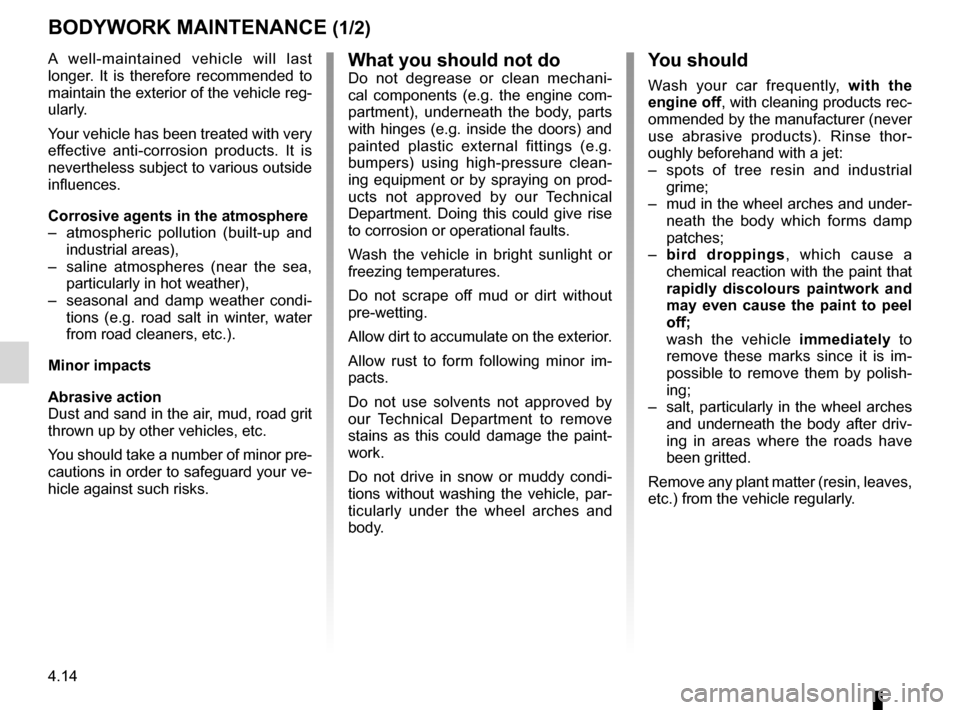
maintenance:bodywork ........................................ (up to the end of the DU)
washing ................................................ (up to the end of the DU)
paintwork maintenance ................................... (up to the end of the DU)
anti-corrosion protection ........................................ (current page)
4.14
ENG_UD26811_2
Entretien de la carrosserie (peinture mate) (X44 - X77 - J77 - X85 - \
B90 - X61 - TEST - X77 ph2 - X95 - B95 - D95 - K95 - J95 - R95 - L90 Ph2 - F90 Ph2 - R90\
Ph2 - X62
ENG_NU_813-11_FK61_Renault_4
Jaune NoirNoir texte
Bodywork maintenance
BoDyWoRk MAIntenAnCe (1/2)
you should
Wash your car frequently, with the
engine off, with cleaning products rec-
ommended by the manufacturer (never
use abrasive products). Rinse thor -
oughly beforehand with a jet:
– spots of tree resin and industrial
grime;
– mud in the wheel arches and under -
neath the body which forms damp
patches;
– bird droppings , which cause a
chemical reaction with the paint that
rapidly discolours paintwork and
may even cause the paint to peel
off;
wash the vehicle immediately to
remove these marks since it is im -
possible to remove them by polish -
ing;
– salt, particularly in the wheel arches
and underneath the body after driv -
ing in areas where the roads have
been gritted.
Remove any plant matter (resin, leaves,
etc.) from the vehicle regularly.
What you should not doDo not degrease or clean mechani -
cal components (e.g. the engine com -
partment), underneath the body, parts
with hinges (e.g. inside the doors) and
painted plastic external fittings (e.g.
bumpers) using high-pressure clean -
ing equipment or by spraying on prod-
ucts not approved by our Technical
Department. Doing this could give rise
to corrosion or operational faults.
Wash the vehicle in bright sunlight or
freezing temperatures.
Do not scrape off mud or dirt without
pre-wetting.
Allow dirt to accumulate on the exterior.
Allow rust to form following minor im -
pacts.
Do not use solvents not approved by
our Technical Department to remove
stains as this could damage the paint-
work.
Do not drive in snow or muddy condi -
tions without washing the vehicle, par-
ticularly under the wheel arches and
body.
A well-maintained vehicle will last
longer. It is therefore recommended to
maintain the exterior of the vehicle reg-
ularly.
Your vehicle has been treated with very
effective anti-corrosion products. It is
nevertheless subject to various outside
influences.
Corrosive agents in the atmosphere
–
atmospheric pollution (built-up and
industrial areas),
– saline atmospheres (near the sea,
particularly in hot weather),
– seasonal and damp weather condi -
tions (e.g. road salt in winter, water
from road cleaners, etc.).
Minor impacts
Abrasive action
Dust and sand in the air, mud, road grit
thrown up by other vehicles, etc.
You should take a number of minor pre-
cautions in order to safeguard your ve-
hicle against such risks.
Page 174 of 237
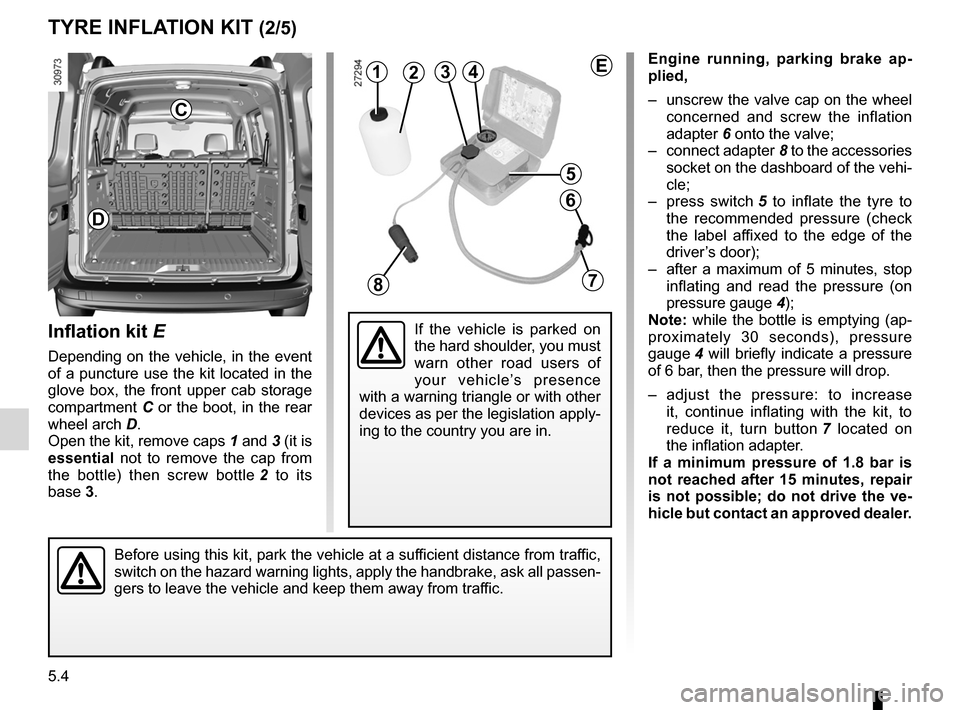
5.4
ENG_UD29751_1
Kit de gonflage des pneumatiques (2 kits) (X61 - F61 - K61 - Renault)\
ENG_NU_813-11_FK61_Renault_5
Jaune NoirNoir texte
engine running, parking brake ap -
plied,
– unscrew the valve cap on the wheel
concerned and screw the inflation
adapter 6 onto the valve;
– connect adapter 8 to the accessories
socket on the dashboard of the vehi-
cle;
– press switch 5 to inflate the tyre to
the recommended pressure (check
the label affixed to the edge of the
driver’s door);
– after a maximum of 5 minutes, stop
inflating and read the pressure (on
pressure gauge 4);
note: while the bottle is emptying (ap-
proximately 30 seconds), pressure
gauge 4 will briefly indicate a pressure
of 6 bar, then the pressure will drop.
– adjust the pressure: to increase
it, continue inflating with the kit, to
reduce it, turn button 7 located on
the inflation adapter.
If a minimum pressure of 1.8 bar is
not reached after 15 minutes, repair
is not possible; do not drive the ve-
hicle but contact an approved dealer.
Inflation kit E
Depending on the vehicle, in the event
of a puncture use the kit located in the
glove box, the front upper cab storage
compartment C or the boot, in the rear
wheel arch D.
Open the kit, remove caps 1 and 3 (it is
essential not to remove the cap from
the bottle) then screw bottle 2 to its
base 3.
tyre InFlatIOn KIt (2/5)
143
5
6
78
2
Before using this kit, park the vehicle at a sufficient distance from traffic,
switch on the hazard warning lights, apply the handbrake, ask all passen-
gers to leave the vehicle and keep them away from traffic.
D
If the vehicle is parked on
the hard shoulder, you must
warn other road users of
your vehicle’s presence
with a warning triangle or with other
devices as per the legislation apply-
ing to the country you are in.
c
e
Page 185 of 237
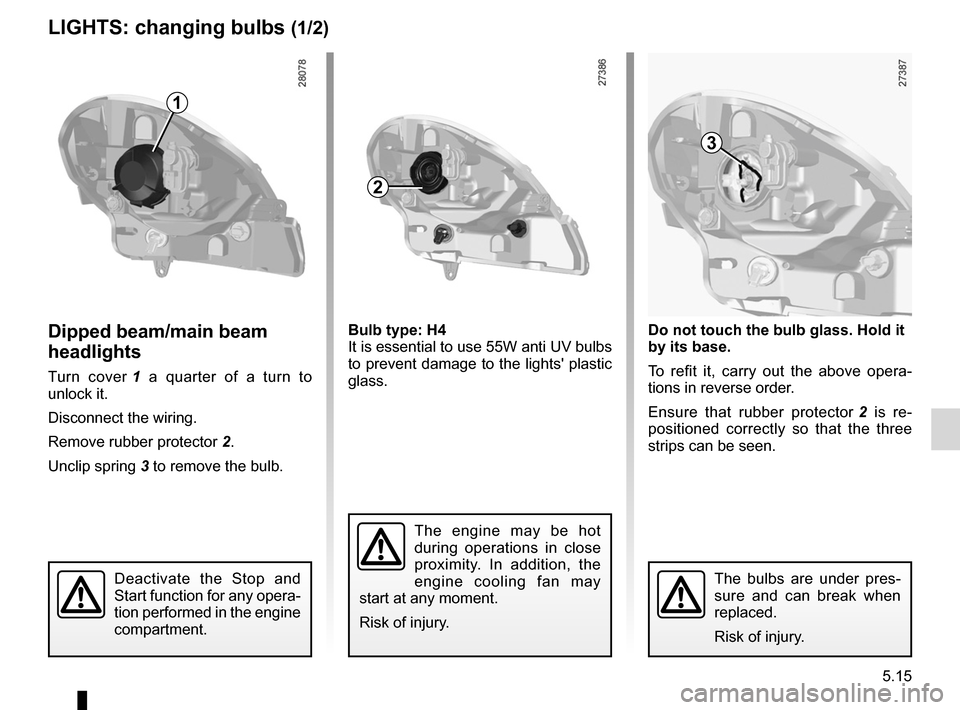
bulbschanging ......................................... (up to the end of the DU)
changing a bulb .................................... (up to the end of the DU)
front lights changing bulbs ................................ (up to the end of the DU)
bulbs changing ......................................... (up to the end of the DU)
lights: dipped beam headlights ................................... (current page)
lights changing bulbs ................................ (up to the end of the DU)
lights front ................................................. (up to the end of the DU)
5.15
ENG_UD25826_4
Projecteurs : remplacement des lampes (X61 - F61 - K61 - Renault)
ENG_NU_813-11_FK61_Renault_5
Headlights: changing bulbs
The bulbs are under pres -
sure and can break when
replaced.
Risk of injury.
Dipped beam/main beam
headlights
Turn cover 1 a quarter of a turn to
unlock it.
Disconnect the wiring.
Remove rubber protector 2.
Unclip spring 3 to remove the bulb.
lIghts: changing bulbs (1/2)
1
2
3
Do not touch the bulb glass. hold it
by its base.
To refit it, carry out the above opera -
tions in reverse order.
Ensure that rubber protector 2 is re -
positioned correctly so that the three
strips can be seen.
The engine may be hot
during operations in close
proximity. In addition, the
engine cooling fan may
start at any moment.
Risk of injury.
Deactivate the Stop and
Start function for any opera -
tion performed in the engine
compartment.
Bulb type: h4
It is essential to use 55W anti UV bulbs
to prevent damage to the lights' plastic
glass.
Page 186 of 237
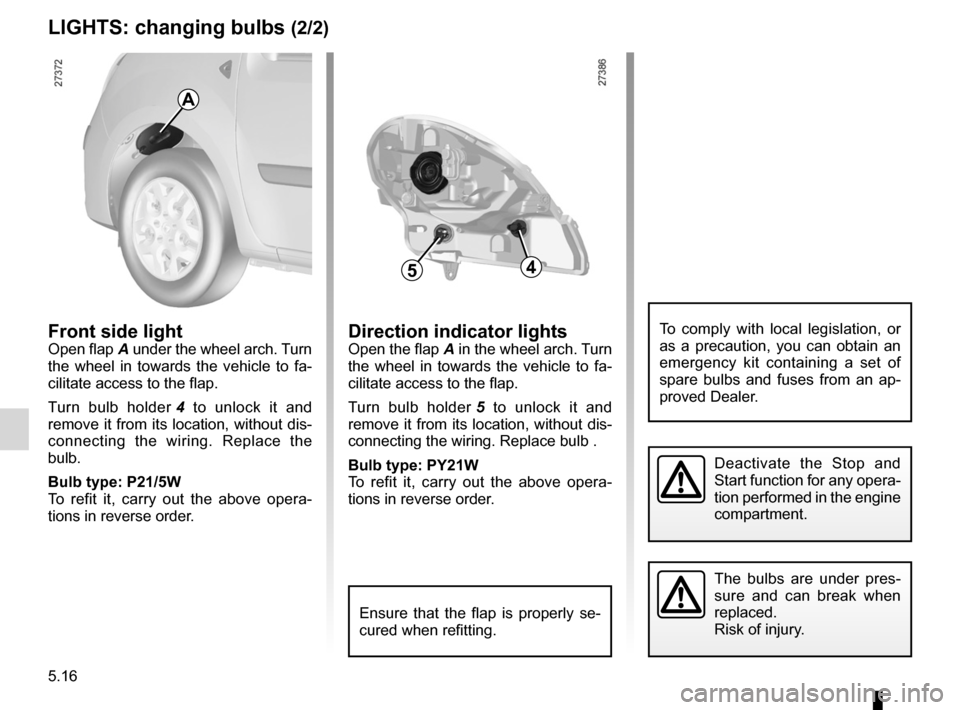
indicators ............................................................... (current page)
indicators: direction indicators ........................................... (current page)
5.16
ENG_UD25826_4
Projecteurs : remplacement des lampes (X61 - F61 - K61 - Renault)
ENG_NU_813-11_FK61_Renault_5
Front side lightOpen flap A under the wheel arch. Turn
the wheel in towards the vehicle to fa-
cilitate access to the flap.
Turn bulb holder 4 to unlock it and
remove it from its location, without dis-
connecting the wiring. Replace the
bulb.
Bulb type: P21/5w
To refit it, carry out the above opera -
tions in reverse order.Direction indicator lightsOpen the flap A in the wheel arch. Turn
the wheel in towards the vehicle to fa-
cilitate access to the flap.
Turn bulb holder 5 to unlock it and
remove it from its location, without dis-
connecting the wiring. Replace bulb .
Bulb type: Py21w
To refit it, carry out the above opera -
tions in reverse order.
The bulbs are under pres -
sure and can break when
replaced.
Risk of injury.
lIghts : changing bulbs (2/2)
45
a
Ensure that the flap is properly se -
cured when refitting.
Deactivate the Stop and
Start function for any opera -
tion performed in the engine
compartment.
To comply with local legislation, or
as a precaution, you can obtain an
emergency kit containing a set of
spare bulbs and fuses from an ap -
proved Dealer.
Page 187 of 237
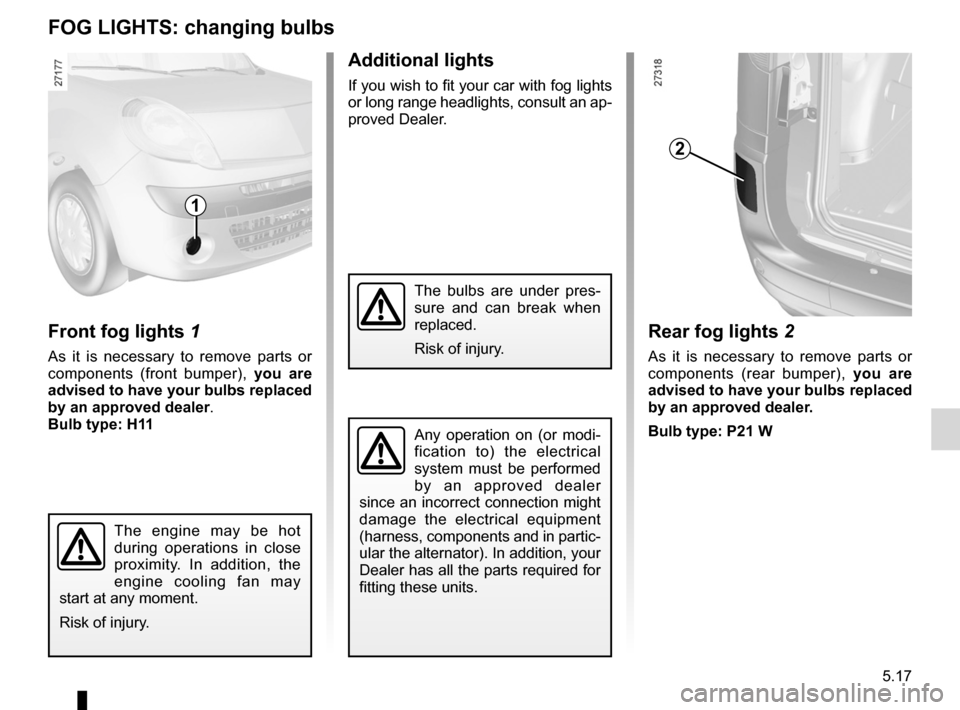
bulbschanging ......................................... (up to the end of the DU)
fog lights ............................................... (up to the end of the DU)
changing a bulb .................................... (up to the end of the DU)
bulbs changing ......................................... (up to the end of the DU)
lights: fog lights ......................................... (up to the end of the DU)
lights fog lights ......................................... (up to the end of the DU)
5.17
ENG_UD6842_3
Feux de brouillard : remplacement des lampes (X61 - F61 - K61 - Renault\
)
ENG_NU_813-11_FK61_Renault_5
Front fog lights 1
As it is necessary to remove parts or
components (front bumper), you are
advised to have your bulbs replaced
by an approved dealer.
Bulb type: h11
additional lights
If you wish to fit your car with fog lights
or long range headlights, consult an ap-
proved Dealer.
Feux de brouillard : remplacement des lampes
FOg lIghts: changing bulbs
1
The engine may be hot
during operations in close
proximity. In addition, the
engine cooling fan may
start at any moment.
Risk of injury.
Any operation on (or modi -
fication to) the electrical
system must be performed
by an approved dealer
since an incorrect connection might
damage the electrical equipment
(harness, components and in partic-
ular the alternator). In addition, your
Dealer has all the parts required for
fitting these units.
rear fog lights 2
As it is necessary to remove parts or
components (rear bumper), you are
advised to have your bulbs replaced
by an approved dealer.
Bulb type: P21 w
2
The bulbs are under pres -
sure and can break when
replaced.
Risk of injury.
Page 194 of 237
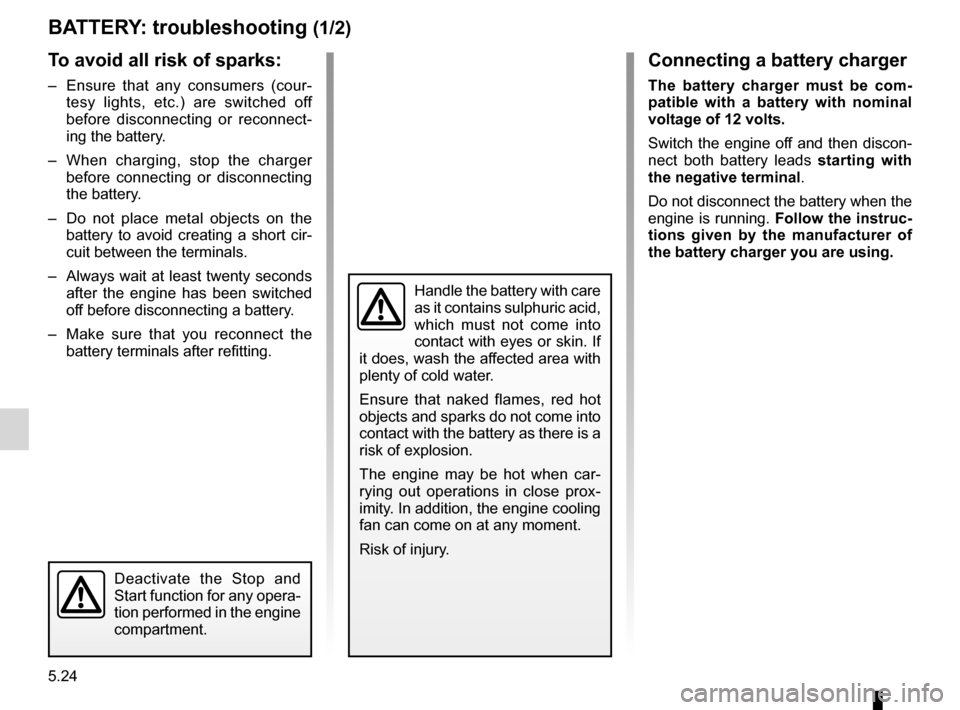
batterytroubleshooting ............................... (up to the end of the DU)
5.24
ENG_UD26102_3
Batterie : dépannage (X61 - F61 - K61 - Renault)
ENG_NU_813-11_FK61_Renault_5
Jaune NoirNoir texte
Battery: breakdown
Battery: troubleshooting (1/2)
Handle the battery with care
as it contains sulphuric acid,
which must not come into
contact with eyes or skin. If
it does, wash the affected area with
plenty of cold water.
Ensure that naked flames, red hot
objects and sparks do not come into
contact with the battery as there is a
risk of explosion.
The engine may be hot when car -
rying out operations in close prox -
imity. In addition, the engine cooling
fan can come on at any moment.
Risk of injury.
t o avoid all risk of sparks:
– Ensure that any consumers (cour -
tesy lights, etc.) are switched off
before disconnecting or reconnect -
ing the battery.
– When charging, stop the charger
before connecting or disconnecting
the battery.
– Do not place metal objects on the
battery to avoid creating a short cir-
cuit between the terminals.
– Always wait at least twenty seconds
after the engine has been switched
off before disconnecting a battery.
– Make sure that you reconnect the
battery terminals after refitting.
Deactivate the Stop and
Start function for any opera -
tion performed in the engine
compartment.
connecting a battery charger
t he battery charger must be com -
patible with a battery with nominal
voltage of 12 volts.
Switch the engine off and then discon-
nect both battery leads starting with
the negative terminal.
Do not disconnect the battery when the
engine is running. Follow the instruc-
tions given by the manufacturer of
the battery charger you are using.
Page 195 of 237
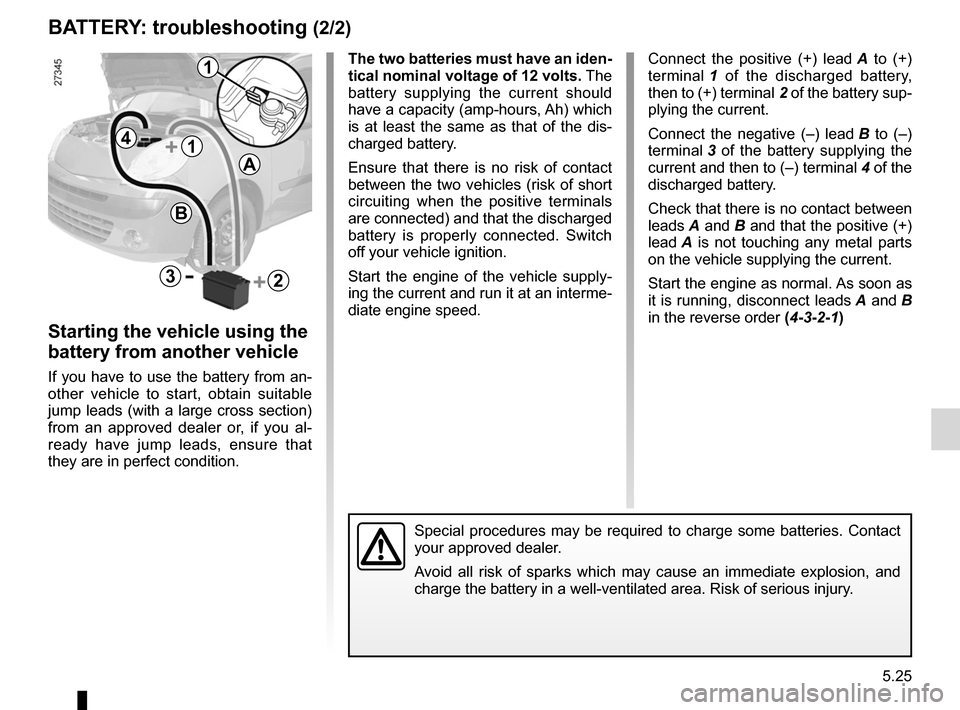
JauneNoirNoir texte
5.25
ENG_UD26102_3
Batterie : dépannage (X61 - F61 - K61 - Renault)
ENG_NU_813-11_FK61_Renault_5
1
a
2
4
B
3
Battery: troubleshooting (2/2)
Connect the positive (+) lead A to (+)
terminal 1 of the discharged battery,
then to (+) terminal 2 of the battery sup-
plying the current.
Connect the negative (–) lead B to (–)
terminal 3 of the battery supplying the
current and then to (–) terminal 4 of the
discharged battery.
Check that there is no contact between
leads A and B and that the positive (+)
lead A is not touching any metal parts
on the vehicle supplying the current.
Start the engine as normal. As soon as
it is running, disconnect leads A and B
in the reverse order (4-3-2-1)
the two batteries must have an iden-
tical nominal voltage of 12 volts. The
battery supplying the current should
have a capacity (amp-hours, Ah) which
is at least the same as that of the dis-
charged battery.
Ensure that there is no risk of contact
between the two vehicles (risk of short
circuiting when the positive terminals
are connected) and that the discharged
battery is properly connected. Switch
off your vehicle ignition.
Start the engine of the vehicle supply
-
ing the current and run it at an interme-
diate engine speed.
Special procedures may be required to charge some batteries. Contact
your approved dealer.
Avoid all risk of sparks which may cause an immediate explosion, and
charge the battery in a well-ventilated area. Risk of serious injury.
1
starting the vehicle using the
battery from another vehicle
If you have to use the battery from an-
other vehicle to start, obtain suitable
jump leads (with a large cross section)
from an approved dealer or, if you al -
ready have jump leads, ensure that
they are in perfect condition.
Page 197 of 237
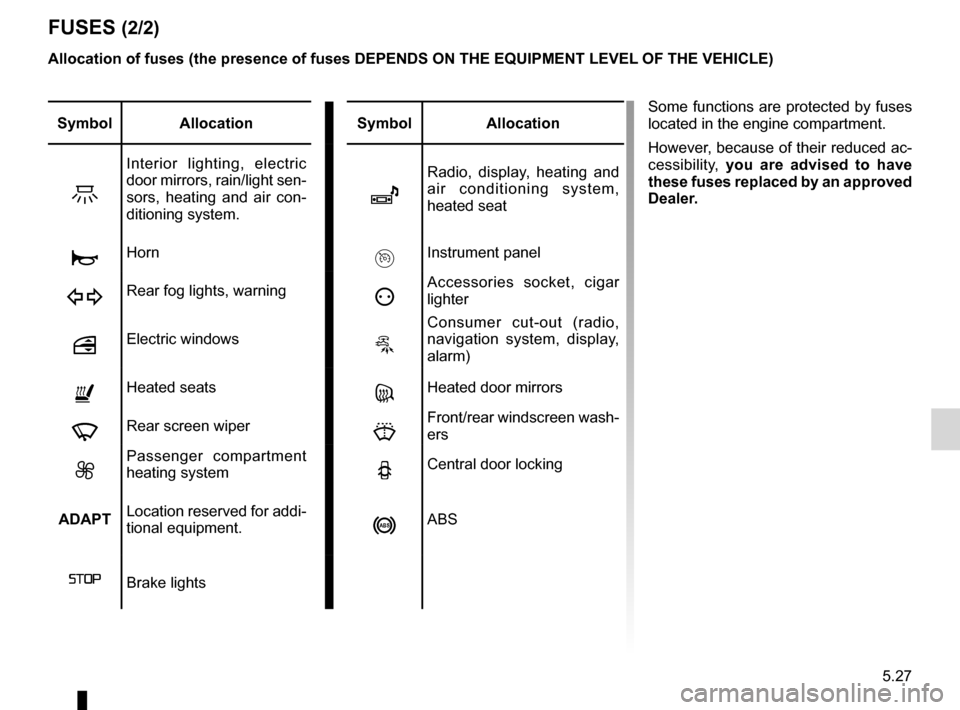
JauneNoirNoir texte
5.27
ENG_UD23043_4
Fusibles (X61 - F61 - K61 - Renault)
ENG_NU_813-11_FK61_Renault_5
Fuses (2/2)
Some functions are protected by fuses
located in the engine compartment.
However, because of their reduced ac-
cessibility, you are advised to have
these fuses replaced by an approved
Dealer.symbol allocation symbolallocation
Z
Interior lighting, electric
door mirrors, rain/light sen-
sors, heating and air con -
ditioning system.
î
Radio, display, heating and
air conditioning system,
heated seat
ÌHornInstrument panel
DRear fog lights, warningëAccessories socket, cigar
lighter
Electric windowsö
Consumer cut-out (radio,
navigation system, display,
alarm)
ñHeated seatsgHeated door mirrors
fRear screen wiperHFront/rear windscreen wash-
ers
xPassenger compartment
heating systemNCentral door locking
aDaPt Location reserved for addi
-
tional equipment.
nABS
ßBrake lights
allocation of fuses (the presence of fuses DePenDs On the eQuIPment leVel
OF the VehIcle)
Page 198 of 237
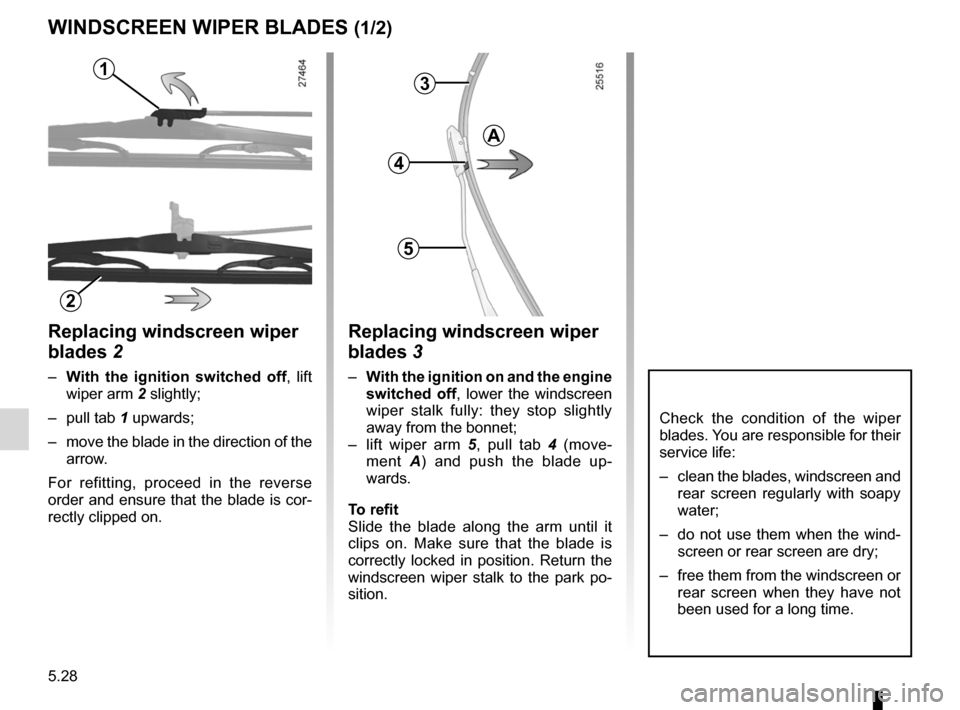
wiper blades ......................................... (up to the end of the DU)
windscreen washer/wiper replacing blades .............................. (up to the end of the DU)
5.28
ENG_UD26546_5
Balais d’essuie-vitre (X61 - F61 - K61 - Renault)
ENG_NU_813-11_FK61_Renault_5
Jaune NoirNoir texte
Wiper blades
replacing windscreen wiper
blades 2
– with the ignition switched off , lift
wiper arm 2 slightly;
– pull tab 1 upwards;
– move the blade in the direction of the
arrow.
For refitting, proceed in the reverse
order and ensure that the blade is cor-
rectly clipped on.
wInDscreen wIPer BlaDes (1/2)
Check the condition of the wiper
blades. You are responsible for their
service life:
– clean the blades, windscreen and
rear screen regularly with soapy
water;
– do not use them when the wind-
screen or rear screen are dry;
– free them from the windscreen or
rear screen when they have not
been used for a long time.
1
replacing windscreen wiper
blades 3
– with the ignition on and the engine
switched off, lower the windscreen
wiper stalk fully: they stop slightly
away from the bonnet;
– lift wiper arm 5 , pull tab 4 (move -
ment A ) and push the blade up -
wards.
t o refit
Slide the blade along the arm until it
clips on. Make sure that the blade is
correctly locked in position. Return the
windscreen wiper stalk to the park po-
sition.
3
4
5
a
2
Page 200 of 237
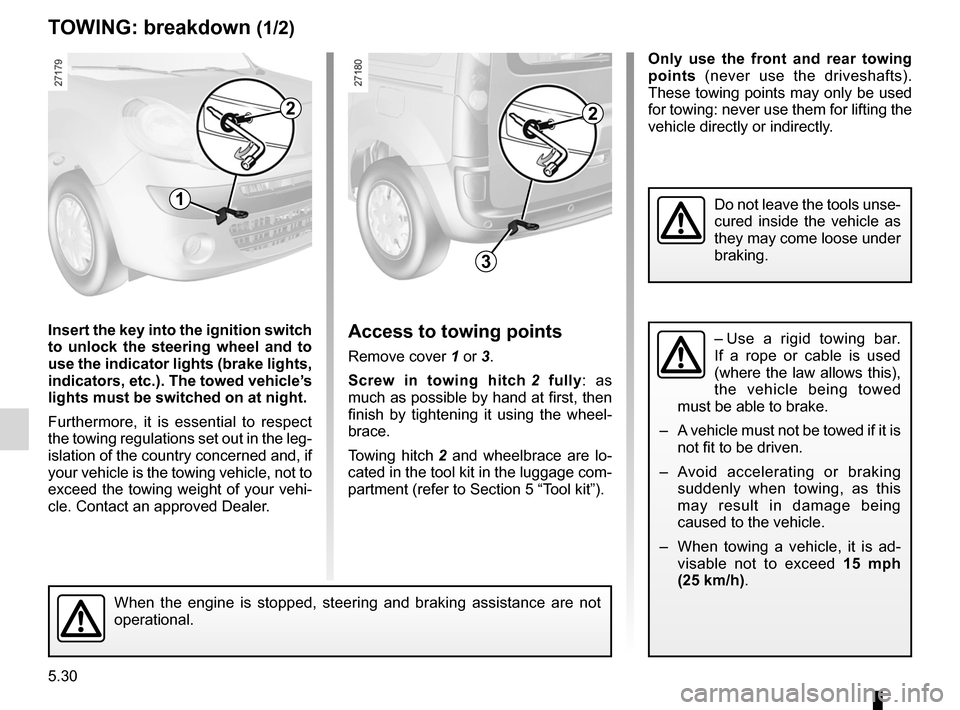
towing hitch............................................................ (current page)
towing breakdown ....................................................... (current page)
5.30
ENG_UD9721_2
Remorquage : dépannage (X61 - F61 - K61 - Renault)
ENG_NU_813-11_FK61_Renault_5
Jaune NoirNoir texte
access to towing points
Remove cover 1 or 3.
s crew in towing hitch 2 fully : as
much as possible by hand at first, then
finish by tightening it using the wheel -
brace.
Towing hitch 2 and wheelbrace are lo -
cated in the tool kit in the luggage com-
partment (refer to Section 5 “Tool kit”).
Towing: breakdown
t OwIng: breakdown (1/2)
Insert the key into the ignition switch
to unlock the steering wheel and to
use the indicator lights (brake lights,
indicators, etc.). the towed vehicle’s
lights must be switched on at night.
Furthermore, it is essential to respect
the towing regulations set out in the leg-
islation of the country concerned and, if
your vehicle is the towing vehicle, not to
exceed the towing weight of your vehi-
cle. Contact an approved Dealer.
When the engine is stopped, steering and braking assistance are not
operational.
Only use the front and rear towing
points (never use the driveshafts).
These towing points may only be used
for towing: never use them for lifting the
vehicle directly or indirectly.
1
3
22
Do not leave the tools unse-
cured inside the vehicle as
they may come loose under
braking.
– Use a rigid towing bar.
If a rope or cable is used
(where the law allows this),
the vehicle being towed
must be able to brake.
– A vehicle must not be towed if it is
not fit to be driven.
– Avoid accelerating or braking
suddenly when towing, as this
may result in damage being
caused to the vehicle.
– When towing a vehicle, it is ad -
visable not to exceed 15 mph
(25 km/h).